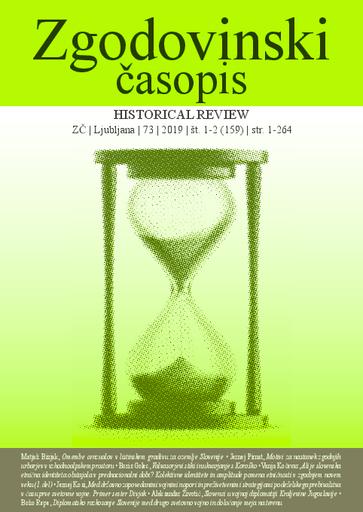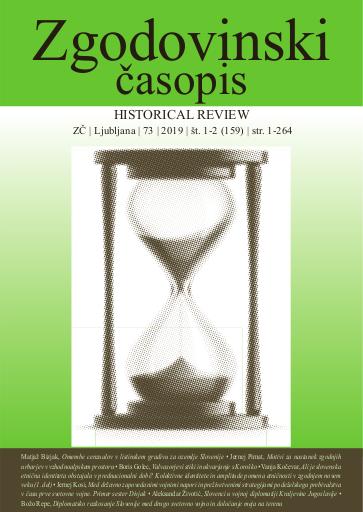/
Serijske publikacije
/
Zgodovinski časopis
Omembe cenzualov v listinskem gradivu za ozemlje Slovenije

Avtor(ji):Matjaž Bizjak
Soavtor(ji):Peter Štih (odg. ur.), Saša Mlacović (prev.), Vesna Vidmar (drugo)
Leto:2019
Založnik(i):Zveza zgodovinskih društev Slovenije
Jezik(i):slovenščina, angleščina
Vrst(e) gradiva:besedilo
Ključne besede:cenzuali, osvobajanje, socialna zgodovina, srednji vek, censuales, liberation, social history, the Middle Ages
Avtorske pravice:

To delo avtorja Matjaž Bizjak je ponujeno pod Creative Commons Priznanje avtorstva-Nekomercialno-Deljenje pod enakimi pogoji 4.0 Mednarodna
Datoteke (1)

Ime:ZC_2019_1-2.pdf
Velikost:11.75MB
Format:application/pdf
Stalna povezava:https://hdl.handle.net/11686/file25389
Opis
Članek obravnava poseben družbeni sloj cenzualov, prvotno nesvobodnjakov, ki so z
»osvoboditvijo« in obenem darovanjem na oltar pridobili status omejene svobode in so
bili v visokem srednjem veku razširjeni na območju Bavarske in nanjo navezanih alpskih
dežel. Obravnavani so vsi (znani) dokumentirani primeri za slovensko ozemlje, ki presenetljivo
segajo do štiridesetih let 14. stoletja.
Metapodatki (12)
- identifikatorhttps://hdl.handle.net/11686/41439
- naslov
- Omembe cenzualov v listinskem gradivu za ozemlje Slovenije
- References to Censuales in Documents Pertaining to the Slovene Territory
- ustvarjalec
- Matjaž Bizjak
- soavtor
- Peter Štih (odg. ur.)
- Saša Mlacović (prev.)
- Vesna Vidmar (drugo)
- predmet
- cenzuali
- osvobajanje
- socialna zgodovina
- srednji vek
- censuales
- liberation
- social history
- the Middle Ages
- opis
- The term censualis denotes an individual who was unfree by birth and subsequently set free. This liberation implied an improved personal position; however, it did not bring absolute freedom. Freedmen were usually conveyed to an ecclesiastical institution (a bishopric, a monastery, etc.) or, more often, to a specifi c altar in a church, to which they were tied by way of annual tributes in money, i.e. census. This census (poll tax) was paid in a symbolic amount of three or fi ve pence and marked a censualis’ liberation. It was generally intended for covering the lighting cost of the relevant altar, i.e. the acquisition of wax or oil. On the other hand, census enjoined the ecclesiastical lord to protect the censualis’ freedom against third parties and against one’s own arbitrariness. Naturally, failure to pay census resulted in loss of freedom; if a censualis defaulted on their obligation for three years, they became their patron’s serf. The main differences that distinguished a censualis from their former unfree status included deliverance from their daily or weekly obligations, i.e. labour, and a relative freedom of movement, which was still regulated by lord-patron, to whom a censualis belonged to some extent. A lord could settle a censualis on their hide, in their urban settlements, while in some instances censales were settled also outside their original seigneury following an agreement with their lord. Regardless of the tributes determined by the new arrangement a censualis had to pay an annual census to their lord-patron. The phenomenon of censuales has a broader European dimension and is present, fi rst and foremost, in the area extending from Flanders and Westfalia to central France, Lotharingia and Rhineland to Bavaria, the Alpine lands and northern Italy. In the Bavarian-Alpine area this social element has been largely documented in many Traditionsbücher of ecclesiastical institutions (bishoprics and monasteries), which are typical of this area, particularly from the second half of the twelfth century onwards. Unless they transitioned into the urban population, they are believed to have gradually assimilated in the thirteenth century into the broad social stratum of the rural population with limited freedom, which was in the Slovene area formed mostly through the incorporation of the formerly free members of Old Slavic župas.What they had in common with the censuales was, fi rst and foremost, deliverance from weekly labour. Contrary to popular belief, the liberation or the acquisition of the status of a censualis can be observed in sources related to the Slovene territory also in the late Middle Ages. In the fi rst half of the fourteenth century this type of liberation was still a fairly usual occurrence, which indicates a strong parallel between this and the former period, while partly individual transitional forms can be detected as well. The liberation brought about a relatively more fl exible stratum of subordinate people who could obtain land for cultivation within a seigneury on better terms or settle in bourgs or urban settlements emerging in the Slovene territory in the period in question. When liberating formerly unfree individuals two goals are at the forefront; namely, to ensure better living conditions for the freedman as well as means for lighting a particular church or its altar. Cases highlighted in the article at hand indicate that the emergence of the social stratum of censuales in the Slovene territory was not as inconsequential as can be gathered from its (lacking) presence in the existing Slovene historiography. Bearing in mind publications produced thus far, instances of active formation of this social stratum, i.e. the actual liberation rather than merely documenting the existence of censuales as a social relic, put Carniola in the fi rst half of the fourteenth century in an exceptional position if compared to that of the neighbouring Alpine lands and Bavaria. It is somewhat surprising that the phenomenon was not documented in a large part of the thirteenth century, which is not necessarily a sign of discontinuity; this is more likely a consequence of the state of preservation or knowledge of sources.
- založnik
- Zveza zgodovinskih društev Slovenije
- datum
- 2019
- 01. 05. 2019
- tip
- besedilo
- jezik
- Slovenščina
- Angleščina
- jeDelOd
- pravice
- licenca: ccByNcSa
